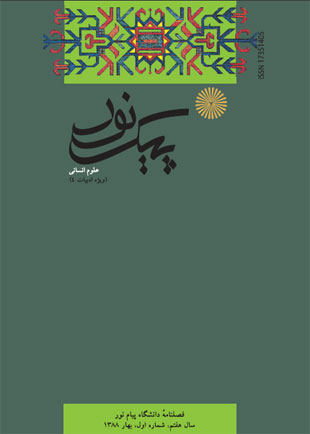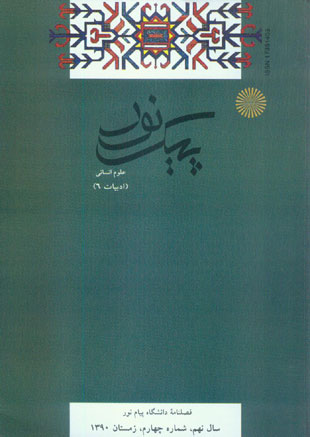فهرست مطالب

فصلنامه پیک نور (علوم انسانی)
سال هفتم شماره 1 (بهار 1388)
- ویژه ی ادبیات
- 142 صفحه، بهای روی جلد: 6,000ريال
- تاریخ انتشار: 1388/03/20
- تعداد عناوین: 12
- مقاله
-
صفحه 32
-
صفحه 101
-
صفحه 114
-
صفحه 118
- مراجع و تازه های علمی
-
Page 3Myths are communal dreams of human beings and mythological symbols are the artistic and secret language of the myths. They increase the deepness of the meanings when they are used in poems. Symbols with their formable and flexible nature are able to reflect the deep and rooted concepts and subjects in a comprehensive way due to the time and place conditions.They are able to produce different meanings and uses out of a single from and to continue their novelty and continuity with a consistent growth. Of course symbolic poets and artists due to their cultural background and their individual and social real needs, may pay special attention to the use of symbols; but the author of this article, while considering the theoretical bases of the usage of symbols and the related subjects, tries to survey the most important factors that lead poets to use plants symbols and myths. The author also tries to have a look at the uses of these kinds of symbols in the myths of different tribes and nations so that he can compare them in real and better way.
-
Page 22In this paper the aim of Machiavellism and its political style are discussed. The final goal of Machiavellism is to reach power, maintaining and protecting it and its political style is reaching political goals from any possible ways, because for reaching the power of the rulers, a person can easily forget the moralities.
-
Page 32Hossein Vaẻzi Kashefi is a popular Iranian poet living in the 10th century (A.H). His works, in various aspects of science, amounts to more than 40 volumes. It is considerable to know that his fame has been forwarded beyond the geographical borders of Iran. He played an effective role in accomplishing the vast language, literature and culture of India and Pakistan. In this essay, Kashefi's spiritual presence has been contemplated in two parts: the translations of Kashefi's works published in different titeles and large quantity of manuscripts and also the transcription of his works.
-
Page 40Comparative literature as a dynamic and evolving science had become into existence first in Europe and America then came to Iran. In the beginning of its information in Iran it studied and considered only its general concepts, but later it found its main road and some studies on comparing Persian literature with the literature of other nation have beendone.
-
Page 47Amir Khosrow Dehlavi is one of the creators of Hindi Style who had an important role in its development. All of the features that have been computeting by literarians and critics during two centuries after the stabilization of Hindi style, could be observed in the poems of Dehlavi: This research is studying the most prominent rhetorical characteristics of Dehlavi's poems that have a close relationship with Hindi Style based on his Divan.
-
Page 73The paper is going to study the methods of determination of the homonymous and polysemous entries in Persian to Persian monolingual dictionaries such as Dehkhoda Dictionary (Loghatname-ye-Dehkhoda), Amid Dictionary (Farhang-e-Amid), Dictionary of Contemporary Persian (Farhange Farsi-ye-Emrooz), Sokhan Dictionary (Farhange Bozorge Sokhan) and Persian to English Dictionaries including Aryanpour Progressive Dictionary (Farhenge Pishro Aryanpour) and English to English dictionaries such as: Longman Dictionary of Contemporary English, Oxford Advanced Learner’s Dictionary, Webster’s New Collegiate Dictionary, and American Heritage Dictionary. For this reason the present paper has been divided into several sections.
-
Page 95In Islamic Gnostic the spiritual leader has a special position. His disciples need his guidance to save them from any misleads to reach his destination. In Gnostic books the image of the spiritual leader have been described, and the importance of its existence clearly have discussed. In this way, Sanaee’s Hadigheh and Molavi’s Mathnavi have fundamental roles. Hadigheh as the first book that had brought ethical and Gnostic meaning in Persian literature and Mathnavi as its complement in this way have a great importance. Sanaee by his unique poems and stories refers to the characteristics and the importance of the spiritual leader, but he did not go into details as much as Molana.
-
Page 101One of the highest qualities of Persian literature is having rich Islamic culture at this disposal. On this way, special attendance to the verses of Quran and their meanings, in different aspects, has had a high level position for the Persian literarians and poets, especially first class lecturer, as a powerful source of belief and literature. shams-od-din Mohammad Hafez Shirazi the most famous poet of the eight century of Hejira calendar is one of the artistically inclined artists who could succeed to include Quranic truth as a base in his splendid poems in Persian literature and by doing that he had become the most famous and popular Iranian poet; and captured the heart of many talented people. In this study we wish to study the reasons of creation of the splendid literary works in Iran and the world and analyzing the different aspects of the reflection of the meaning of Quranic verses in the poems of this great poet as well. Also we would show that Quranic truths that rarely included in literary works, had an extraordinary impression on the mind of Hafez, and had become the base of his speech.
-
Page 114In Persian prose and poetry sometimes we encounter some terms that their meanings are not clear or if we try to understand their meanings through the context, because of the fact that those terms cannot be found in the present dictionaries,the meanings we have guessed are not so sure. One of the ways of finding the meaning of such words, is using Persian dialects. This paper aims to study the correct pronunciation and meaning of one of the words that Naser Khosrow had used in one of his odes, by using Shushtari dialect.
-
Page 118Since in the terminology of mystics the term Aan has a special meaning and it is the moment when God has created the creatures to reflect Himself, the poets of Persian literature had used the term in the most artistic way in the eighth century. They knew this term well and to make their poem more beautiful they used it in its original sense artistically.This will help us to have a better understanding and knowledge about the meanings of the words and poems of mystic poets.


